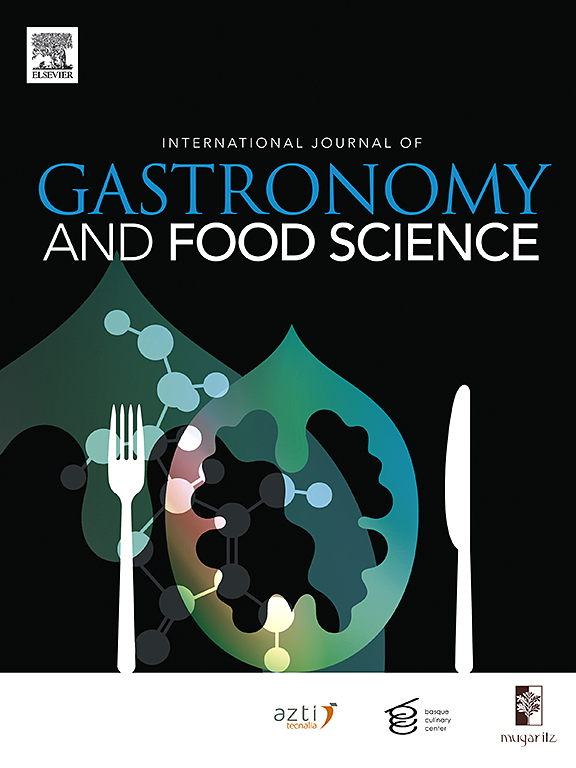Gastronomic treasures of southern Italy: The role of wooden equipment and heritage cheeses
IF 3.2
2区 农林科学
Q2 FOOD SCIENCE & TECHNOLOGY
International Journal of Gastronomy and Food Science
Pub Date : 2025-04-04
DOI:10.1016/j.ijgfs.2025.101179
引用次数: 0
Abstract
Traditional cheese productions are deeply connected to their regions of origin, still made using raw milk from animals of indigenous breeds, traditional techniques and wooden equipment. The use of wooden tools in dairy factories promotes the formation of microbial biofilms, primarily composed of indigenous microorganisms, especially lactic acid bacteria (LAB). These microorganisms are crucial for developing the complex sensory characteristics that reflect the traditional and regional cheese heritage. Although the porous nature of wood has sparked considerable debate, there is no scientific evidence linking it directly to foodborne diseases. In Italy, the use of wooden equipment in cheese production is permitted under Regulation (EC) no. 2074/2005, which provides an exemption from Regulation (EC) no 852/2004 for foods with traditional characteristics related to the materials used in equipment manufacturing, packaging, and wrapping. The microbial biofilms developed onto wooden equipment represent one of the most vital reservoirs of dairy biodiversity. These biofilms not only influence the development of the LAB but also inhibit the main dairy bacterial pathogens (Listeria monocytogens, Salmonella spp., Escherichia coli and Staphylococcus aureus). Besides discussing wooden equipment and microbial biofilms, this review also emphasizes the importance of traditional cheeses in preserving the culinary heritage of specific regions, as well as their significant role in sustainability and economic viability.
意大利南部的美食宝藏:木制设备和传统奶酪的作用
传统的奶酪生产与它们的原产地密切相关,仍然使用来自当地品种动物的生奶、传统技术和木制设备制作。乳制品工厂使用木制工具促进微生物生物膜的形成,主要由本地微生物组成,特别是乳酸菌(LAB)。这些微生物对于发展反映传统和地区奶酪遗产的复杂感官特征至关重要。尽管木材的多孔性引发了相当大的争论,但没有科学证据将其与食源性疾病直接联系起来。在意大利,根据法规(EC) no. 5允许在奶酪生产中使用木制设备。2074/2005,对设备制造、包装和包装中使用的材料具有传统特征的食品提供了法规(EC) 852/2004的豁免。在木制设备上开发的微生物生物膜代表了乳制品生物多样性最重要的水库之一。这些生物膜不仅影响乳酸菌的发育,还能抑制乳酸菌的主要致病菌(单核细胞李斯特菌、沙门氏菌、大肠杆菌和金黄色葡萄球菌)。除了讨论木制设备和微生物生物膜外,本综述还强调了传统奶酪在保护特定地区烹饪遗产方面的重要性,以及它们在可持续性和经济可行性方面的重要作用。
本文章由计算机程序翻译,如有差异,请以英文原文为准。
求助全文
约1分钟内获得全文
求助全文
来源期刊

International Journal of Gastronomy and Food Science
Social Sciences-Cultural Studies
CiteScore
5.30
自引率
10.50%
发文量
170
审稿时长
45 days
期刊介绍:
International Journal of Gastronomy and Food Science is a peer-reviewed journal that explicitly focuses on the interface of food science and gastronomy. Articles focusing only on food science will not be considered. This journal equally encourages both scientists and chefs to publish original scientific papers, review articles and original culinary works. We seek articles with clear evidence of this interaction. From a scientific perspective, this publication aims to become the home for research from the whole community of food science and gastronomy.
IJGFS explores all aspects related to the growing field of the interaction of gastronomy and food science, in areas such as food chemistry, food technology and culinary techniques, food microbiology, genetics, sensory science, neuroscience, psychology, culinary concepts, culinary trends, and gastronomic experience (all the elements that contribute to the appreciation and enjoyment of the meal. Also relevant is research on science-based educational programs in gastronomy, anthropology, gastronomic history and food sociology. All these areas of knowledge are crucial to gastronomy, as they contribute to a better understanding of this broad term and its practical implications for science and society.
 求助内容:
求助内容: 应助结果提醒方式:
应助结果提醒方式:


